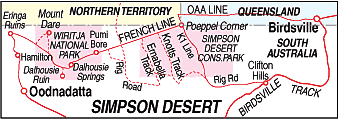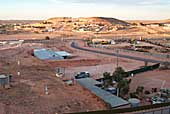|
Select an area from below to automatically open it on this page. |
|
THE SOUTH AUSTRALIAN OUTBACK |
|
The Outback of South Australia is a remarkable place to visit and explore. South Australia is considered the driest state in the
driest continent yet in spring in the outback you will marvel at the millions of wildflowers which rise from the red soil to turn
the state into a carpet of colour. The outback also is not anywhere as dry as you might consider. The Great Australian Artesian Basin, one of the largest underwater basins in the world, lies below the harsh landscape, here and there bubbling to the surface in mound springs or elsewhere tapped by bores to provide sustenance for the millions of head of cattle and sheep, and native animals which congregate around the water sources. Getting to the outback is easy, though it is not a short journey. In the 1980's the Stuart Highway between Adelaide and Alice Springs was completed as a bitumen surface and it is an easy trip these days to take a conventional vehicleto Ayers Rock in Central Australia. The journey is around 1,500 kilometres one way and there are few stops along the way so you need to plan your trip before you go, but it is a comforatble and exhilarating journey. Stark mountain ranges and extensive desert areas make the state one of the most interesting you can visit. Along the way you will pass giant saltpan lakes which fill to capacity after heavy seasonal rains. You will pass through the opal mining town of Coober Pedy which must be one of the most unusual in the world. To beat the heat residents construct magnificent underground homes as they search for the precious stones and they need to be seen to be believed. At Pimba, the turn off to nearby Woomera, you will see where rockets regularly blast off into space as an ongoing programme to explore the universe continues. You will see kangaroos and emus and unusual reptiles and small creatures who thrive in the outback conditions. It is a trip not to be missed and one that will reward you well There are other roads leading north for the more adventurous. The Birdsville Track , the Strzelecki Track and the Oodnadatta Track are legendary in their challenge and beauty. Dirt surfaces crossing massive river beds and winding through spectacular countryside are what the outback is all about. It is nothing for outback station owners to travel several hundred kilometres to visit their neighbours for a chat and a cup of tea, or to get to the local dance or racemeeting. The outback is not just a geographic area, it is a way of life. Massive cattle stations measured in square kilometres rather than acreage, some of them as large as the state of Tasmania; dusty towns where the general store and the local pub are the meeting place for locals and travellers to tell their stories and exchange news, vast expanses which offer brilliant skies at night and fabulous photographs at sunset and sunrise, and most of all the individual beauty of an area untamed or harnessed by man. A trip through the outback by car, rail or coach is a must in your Australian travel plans. SIMPSON DESERT TURNOFF: 11 km. south of Clifton Hills the turn-off to the K1 Line
track overthe Simpson Desert, which connect with Rig Road. (See Map) Another route
leads across the north-west edge of Goyders Lagoon and on to Birdsville. WARNING: Do not attempt to use these routes unless equipped with 4WD vehicle, deatiled maps and adequate supplies and preparation. A Desert Parks Permit is required if entering the Conservation Park or Regional Reserve. 
SIMPSON DESERT CONSERVATION PARK (692,680Ha.) Despite all this, the trip is a most rewarding challenge and one of the most spectacular remaining. SIMPSON DESERT REGIONAL RESERVE 2,964,200Ha. Details are elsewhere on the | Oodnadatta Track and Birdsville Track |


